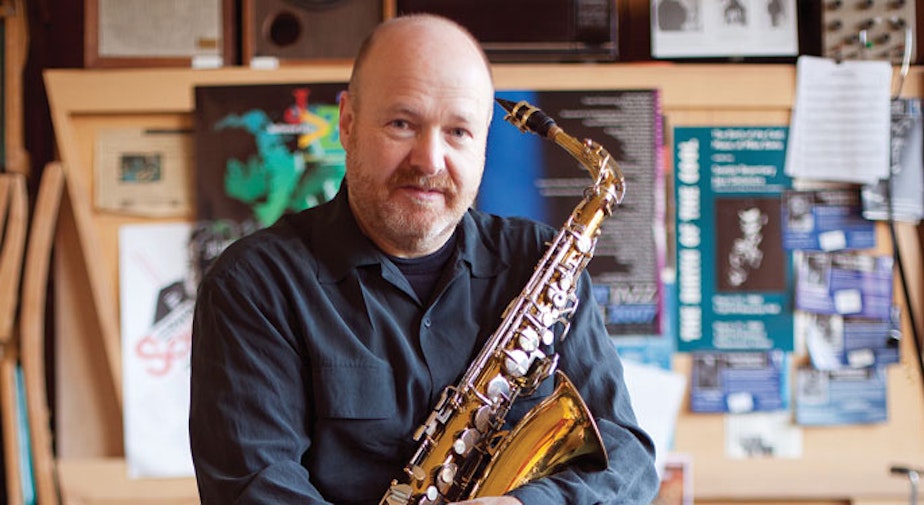Seattle Inventor Finds Key To Solving Saxophone Discord

There’s an old joke among saxophone players: The instrument, they say, comes from the factory out of tune. Dr. Michael Brockman is a professor of saxophone at the University of Washington. He actually thinks the saxophone can be tuned, and he’s determined to do something about it.
The phrase, “it’s close enough for jazz,” doesn’t cut it for Brockman. “You must play in tune, and if you don’t play in tune, you’re not doing your job," he says. "All of my saxophonist students get that stern lecture quite often and it’s a big part of their training."
Brockman doesn’t just lecture about playing in tune. He uses every resource he can muster to help himself and his students improve their intonation. And when it comes to saxophone intonation, you need all the help you can get. "All saxophones are intrinsically out of tune by design. And that mechanism has essentially not changed since the original 1846 patent," says Brockman.
The saxophone intonation problem lies in what are called the octave keys on the saxophone. When a player presses on an octave key, it opens up a vent on the instrument. Air moving through that vent makes the pitch go up one octave. Those vents were not perfectly designed when Adolphe Sax originally invented the instrument in the 1840s.
To the untrained ear, it’s sometimes hard to hear out-of-tune saxophone octaves. But anyone who plays the instrument seriously spends years learning how to use different fingerings for the notes or a different mouth position in an attempt to make those bad octaves sound better.
Sponsored
Brockman is the right man to solve the octave problem. He loves to tinker. “It really started for me when I was a 12 year old and my father and I took a saxophone apart and marked every little screw and piece and set it aside so we could clean it and oil it and put it back together. In the process I learned volumes about how the instrument works and why."
Once Brockman gets an itch to fix or tinker with something, it doesn’t go away.
“Sometimes, I lie awake at night thinking of new designs for things that are just silly, and when I get up the next day I chide myself for staying up later than I should have,” he says.
In working on the octave problem, Brockman pored through articles on acoustics and the physics of sound. He came across the work of Arthur Benade. Benade’s theories predict that if you create new octave vents in just the right places on a saxophone, you can fix the instrument’s tuning problem. So, Dr. Michael Brockman retreated to his laboratory determined to create the perfect octave vent.
“I decided to get an old garage-sale saxophone and start modifying it along the lines of what Arthur Benade was describing by installing a new octave vent for all the various notes that didn’t have one,” he says.
Sponsored
Brockman found himself spending more and more time and energy on the project. He spent so much money trying to create the perfect octave vent that his wife began to worry about family finances. He salvaged parts from old electric lamps, musical instruments and bicycles. He used them to cobble together a strange hybrid saxophone. This monstrous creation had 12 octave vents instead of the usual two. When the instrument came alive in Dr. Brockman’s hands, this grotesque saxophone actually played in tune. He called it “The Frankensax.”
“It does sort of look like Frankenstein’s monster of the saxophone world," admits Brockman. "It’s got all kinds of parts that are taken off of other entities and soldered onto this saxophone."
It’s hard to imagine a saxophonist such as Kenny G. playing the Frankensax. A monstrosity like the Frankensax is ugly and unwieldy and impractical for a performer. Brockman needed a more refined, less invasive way of creating new octave vents on the saxophone. He figured out how to get the same effect as the Frankensax using existing keys on the saxophone.
“I experimented with drilling through the key in order to create a new small vent, and it worked,” says Brockman.
This new key on top of an existing key looks like the push button on a trumpet. Michael calls his invention “The Broctave Key.” And when he uses it, his saxophone is beautifully in tune.
Sponsored
His “Broctave Key” caught the attention of the University of Washington’s Center for Commercialization. The department usually works with UW engineers, computer scientists and medical researchers to develop patented products from their research. They helped Brockman further refine the Brocktave Key. These were satisfying steps in Brockman’s lifelong quest for perfect intonation.
“Having a key that really improves the instrument and that can be used musically and that is a unique invention -- that pretty much sums up the things I like to do with my life," says Brockman.
Just this past fall the Broctave Key was awarded a United States patent. It was the first University of Washington patent to come out of the music school.
